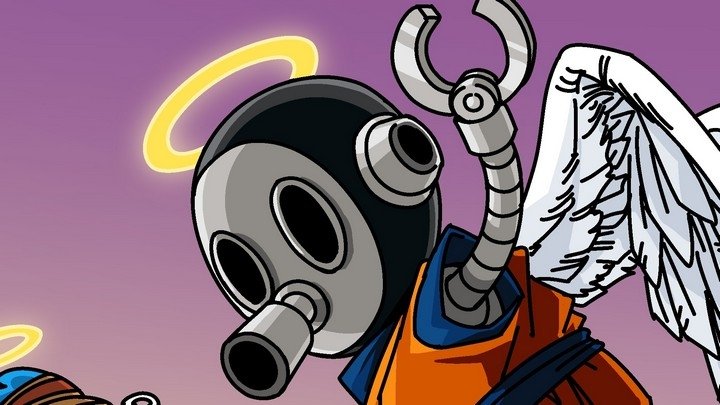What's happening in the world of the Amiga?

The Spectrum is but one string in the bow of computers I intend to write about here on Retronauts. For the times when I don’t necessarily want to bore you with ancient-looking games that feature colours bleeding everywhere, unlistenable beeper music and the like, I might want to look towards something a lil’ prettier, with games that are chock full of 16-bit goodness, pumping sampled soundtracks, and a thoroughly silly amount of parallax scrolling. And for that, I'm going to need to look at the good ol’ Commodore Amiga.
But, wait a minute...the Amiga is an American computer! Commodore are an American company!
Indeed, it was! But it never found all that much success over in the States -- there were several reasons for this, but in the main it failed because Commodore in the US were a completely disorganised mess after Jack Tramiel was fired, meaning that the Amiga was almost never able to find a decent level of marketing beyond niche markets like video editing -- it certainly never managed to establish itself in the home. However, Commodore’s regional hubs were significantly calmer and better managed than the American home base -- and in the late ‘80s to the early ‘90s Commodore’s people in places like the UK and Germany were able to establish the Amiga as the new top home computer on the block. Because of this, there’s a lot of nostalgia for the computer in Europe -- in fact, there’s even a significant and active user base who are still working with the computer today, just as there is with the Spectrum. I intend to talk about Amiga games here, but as with the Spectrum I’m sure you’ll want a bit of a guide to getting the best out of the machine before I dive right in,
Playing Amiga games shouldn’t be a problem, right? Not like that damn Spectrum 48k anyway…
It’s a lot smoother, yes - especially seeing as you can just buy an NTSC Amiga and be done with it. Compatibility can be an issue with some games (again, quite a lot of good Amiga games are European and made for PAL) but it’s not a dealbreaker -- you may experience games running that lil’ bit too fast though, or issues with the game’s music. There are lots of technical ways to get around these problems on an advanced level, although if you’re interested in nothing but games and you don’t want to deal with NTSC problems, you could go ahead and buy a PAL Amiga and pair it up with an NTSC power brick. Display is best with RGB SCART, so it’s good to pair it up with any upscaler, or even an RGB monitor such as the 1084.

Of course, there are a fair few different types of model, although for the purpose of this I’m going to assume you’re mainly interested in games -- and really, the Amiga 500 is by far the best choice for that. It’s the most popular model of machine and most of the games came out for it, plus it’s a really nice looking bit of kit -- especially if you get one that isn’t yellowed. You’ll want to make sure that it comes with a 1 MB trapdoor RAM expansion too - that’ll cover almost everything. The A1200 is the second choice -- much like the Spectrum 128k, there are a few A1200 exclusive games that are worth playing but not a great deal, and it’s far outweighed by a significant loss of compatibility with the A500 games due to the differences between the two systems. The A600 is an absolutely terrible model that's not worth looking at, the A1000 is the iconic first model but quite old and too expensive for purpose, and the top of the line A4000 is more for the serious and committed Amiga user who’s looking for more than just games (and again, is very expensive).
One other option worthy of note, however, is the CD32 -- this is good if you're looking for something console-based. The CD32 may have been a flop, but it is basically a consolized A1200 and does feature a few games worthy of note. More importantly, being an early CD-based system, there is no region or copy protection. There are CD images out there for the system featuring a couple of hundred games all readily playable, most of which were never released for the CD32, that provide a pretty easy solution without dealing with an old computer at all. There is one compromise, mind you -- there's no RGB without a mod. A CD32 does output S-Video out of the box though, if you still have anything that supports it.
Is there anything I should know about software at all?
Well, old floppy discs can have similar issues to old tapes -- if they’ve not been stored very well, there’s a possibility that they can be damaged beyond repair. There are alternatives, of course - one of the best is to buy a Gotek USB floppy drive emulator that allows you to put all your floppy images on a stick, bung it in and forget about it - you can choose multiple discs to load through a menu, and handle your games that way. That’s the basic option - the other more advanced option is to get a CompactFlash card along with a CF-to-IDE converter and use that as a hard drive for your system, which you could then use to fire up games via WHDLoad, a system that in short allows for the installation of games that didn’t originally have installation options. This is also a very good idea if you end up getting an A1200, as it circumvents a lot of the aforementioned compatibility issues.

Let’s cut to the chase -- I’m very lazy and I’m not going to do any of this. Where’s the emulators?
Well, there’s WinUAE -- the best game in town, and pretty much the only one. The WinUAE emulates all models of Amiga without issue, and very accurately - in fact, you can customise it to your heart’s content, and even create a full Amiga setup with it! It can be a little difficult to set up, but the default settings for most models should be good enough for most games -- after all, you can stick most floppies into an Amiga, play them and never think about having to install them. It should be noted, mind you, that WinUAE needs the original Amiga Kickstart ROMs in order to actually function. These are still very much under copyright -- and so there’s no way I’m going to link to any place where you can acquire them here. Said ROMs are owned by Cloanto, who also sell the Amiga Forever emulator suite -- an official, fully set up version of WinUAE that also includes a bunch of games.
All that stuff about Commodore sounds really interesting. Is there anywhere where I can learn more about this system?
There are tons of resources out there, as well as some nice documentaries and the like. The Hall of Light and Lemon Amiga are large resources where you can look up Amiga games, check out box art, ogle over Top 100 lists and see what other people have to say about games. There’s also the Amiga Magazine Rack, which allows you access to scans of many an old Amiga mag from back in the day (whenever I make Amiga-related videos, this is an indispensable resource). Amiga World is a good resource for current news and the like, with a pretty active forum. As far as docs go, Viva Amiga is one of the best new ones -- a solid labour of love featuring interviews with most of the main players connected with the machine. As a rule of thumb, you’re never more than a few steps away from a serious Amiga head on the Internet. There’s also this one person who tends to do a lot of Amiga-related stuff on her YouTube...

Hopefully this brief little primer serves as a nice introduction to the Amiga world as a whole -- at the very least, it should make anything that I write about games for the system on here more sensical. The majority of the links here should certainly take you to something interesting! For now though, I’ll leave you to pore over some of them before getting back to you with some unheralded classics for the machine. For too many people the Amiga conjures up memories of ports that were inferior to the original PC version, or point-and-click games that came on around 30 or so floppy discs...but it was so much more than that. Just remember, and never forget, that Only Amiga Makes It Possible.




